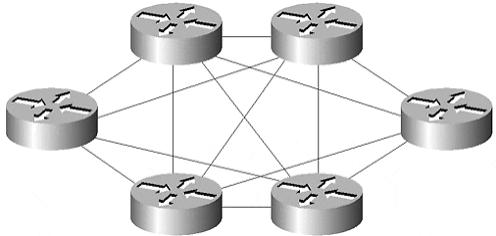CCIE Network Design FAQ: Large Scale Cores
Figure: Full Mesh Neighbors
Q1. Is NHRP a routing protocol, or is it a protocol that helps routing protocols do their job?
Q2. How many paths exist through a network with 30 nodes? 40?
Answer: 30 nodes has 870 paths; 40 nodes has 1560 paths.
Q3. What task does a route server in NHRP perform?
Q4. When a router on an NHRP network wants to find the SVC to use for a given destination, what does it do?
Q5. What three steps are normally involved in routing a packet?
Answer:
- Look up the destination in the routing table.
- Perform a longest prefix match to find the correct destination.
- Rewrite the MAC header on the packet.
Q6. What type of switching paradigm do ATM and Frame Relay use?
Q7. What type of switching paradigm does MPLS use?
Q8. What is a push? A pop?
Q9. What is a FEC?
Q10. Why do you merge FECs?
Q11. Explain each type of label assignment:
Answer:
- Host pair— A label is assigned for each source/destination address.
- Port quadruple— A label is assigned for each source address and port/destination address and port.
- Port quadruple with ToS— A label is assigned for each source address and port/destination address and port with a given ToS, or class of service.
- Network pair— A label is assigned for each source/destination network.
- Destination network— A label is assigned for each destination network.
- Egress router— A label is assigned for each egress router.
- Destination AS— A label is assigned for each destination BGP AS.
Q12. Which device assigns labels in an MPLS network?
Q13. Do downstream devices or upstream devices assign labels?
Q14. What are the two ways of driving label assignment?
· Control driven, where a label is assigned when the routing information changes.
Q15. How is tunneling performed in an MPLS network?
More Resources
